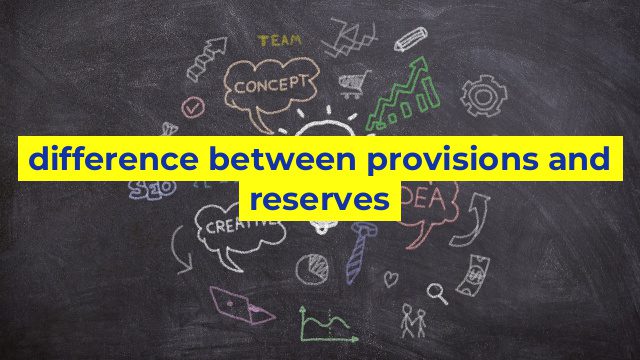The Difference Between Provisions and Reserves
When it comes to accounting, it is important to understand the difference between provisions and reserves. These accounting terms can sometimes be used interchangeably, but they have distinct differences.
What are Provisions?
Provisions are a specific amount of money that is set aside to cover an anticipated expense or liability. For example, a company may set aside a provision for bad debts, which is an estimate of the amount of money that may not be collectible from customers. This provision is set up to ensure that the company has enough money to cover these bad debts when they arise.
Provisions are recorded on the balance sheet as a liability, which means that they reduce the company’s net worth. They are also a way for companies to manage their risk because they can account for potential losses in advance.
What are Reserves?
Reserves, on the other hand, are funds that are set aside to strengthen a company’s financial position. Unlike provisions, reserves are not specifically earmarked for any particular expense or liability.
Reserves can be used to fund future investment or growth opportunities, to pay dividends to shareholders or to cover unforeseen expenses. Reserves are recorded on the balance sheet as equity, which means that they increase the company’s net worth.
The Key Differences
The key difference between provisions and reserves is their purpose. Provisions are set aside to cover specific potential liabilities or expenses, while reserves are general funds set aside to strengthen a company’s financial position.
Another difference is the way they are recorded on the balance sheet. Provisions are recorded as a liability, which means they reduce the company’s net worth. Reserves, on the other hand, are recorded as equity, which increases the company’s net worth.
Conclusion
While provisions and reserves are both important accounting terms, they have distinct differences. Companies use provisions to anticipate and cover specific liabilities, while reserves are more general funds set aside to strengthen the company’s financial position. Understanding the difference between provisions and reserves is essential for any business owner or accountant looking to manage their finances effectively.
Table difference between provisions and reserves
| Provisions | Reserves |
|---|---|
| Provisions are made for identified or uncertain liabilities that are likely to occur in the future. | Reserves are made for a known liability that is expected to occur in the future but the amount and/or timing is uncertain. |
| Provisions are created based on a best estimate of the amount required to settle the liability or obligation. | Reserves are usually created as a percentage of profit, before income tax and extraordinary items. |
| Provisions are recognised as an expense in the income statement, which reduces the company’s profit. | Reserves are generally not recognised as an expense in the income statement, as they are not based on a specific charge against earnings. |
| Provisions can be used to cover specific expenses when they become due, but any unused funds are released back into the company’s profits. | Reserves remain within the company and can be used to cover losses or to invest in the business. |

